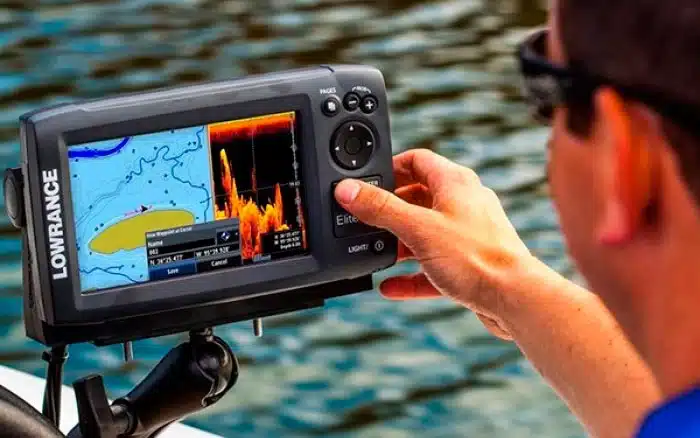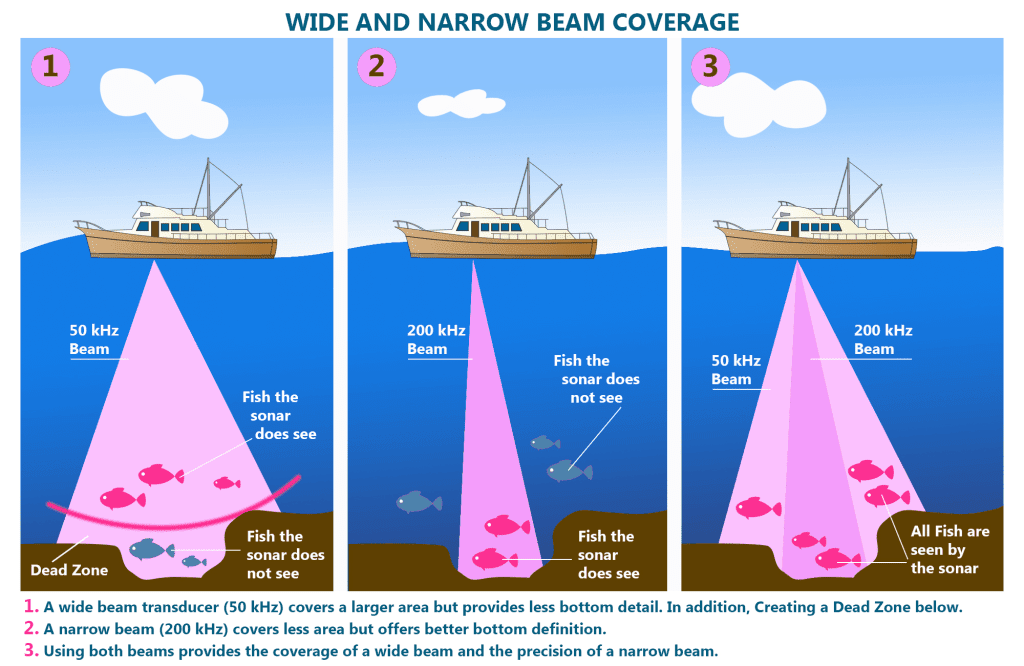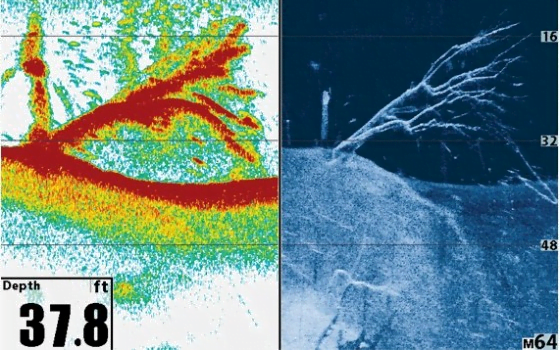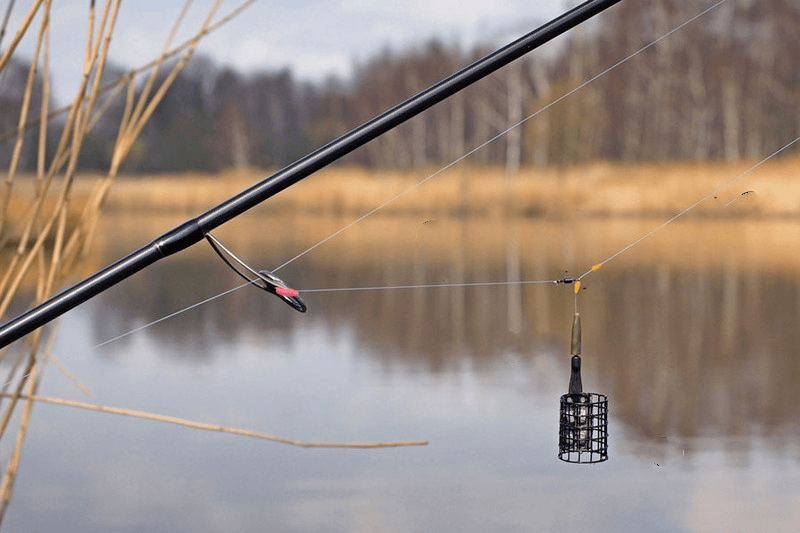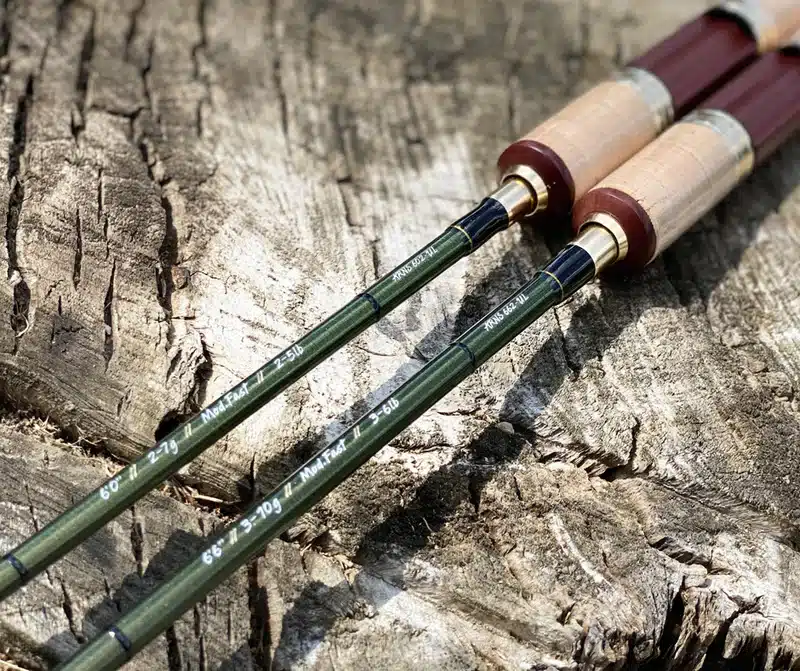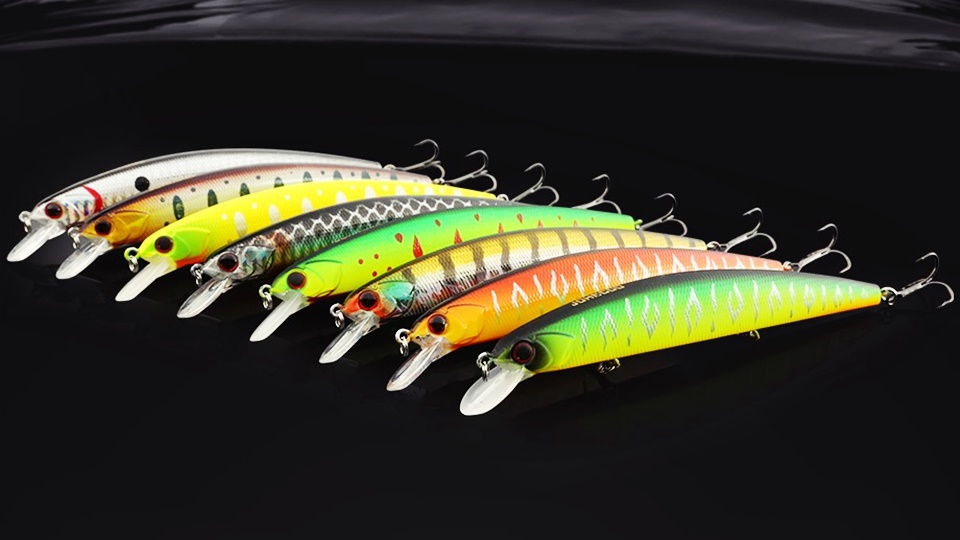Echolotas – tai įrenginys, skirtas rezervuaro gyliui nustatyti, dugno sandarai ir topografijai tirti, žuvims ieškoti. Patys pirmieji echolotai buvo skirti kariniams tikslams – aptikti priešo povandeninius laivus. Vėliau echolotai paplito ir buvo plačiai naudojami žvejybai bei upių ir jūrų laivų kontrolei. Echolotą galima naudoti žvejojant vasarą, tiek žiemą, tiek žvejojant iš valties, ar nuo kranto. Rinkoje yra daugybė echolotų modelių, kurie skiriasi funkcijomis, charakteristikomis ir kaina.
Straipsnyje pabandysime suprasti kaip veikia echolotas. Aptarsime technines charakteristikas ir parametrus, pakalbėsime apie echoloto modelio pasirinkimo principus.
Kam reikalingas echolotas
Viena pagrindinių meškeriotojo užduočių žūklės metu – surasti žuvies buvimo vietas. Patyrę meškeriotojai tam naudoja įvairius metodus:
- Buvimo vietą byloja į paviršių išplaukiančios žuvys.
- Vienoje vietoje sukasi kirų pulkai, rodantys, kad šioje vietoje yra didelė mailiaus koncentracija.
- Mėgstamiausios plėšriųjų žuvų stovėjimo vietos, susijusios su dugno reljefu: duobės, pakrantės ir kanalų pakraščiai, plotai su medžių ir krūmų šakomis ant dugno.
Žvejui gali būti naudinga žinoti, kokiame gylio horizonte yra žuvis žvejybos dieną: žuvis gali stovėti dugne, būti viduriniam vandens sluoksnyje ar pačiame paviršiuje.
Šiuolaikinis elektroninis prietaisas – echolotas – padeda atsakyti į visus šiuos klausimus. Žvejų naudojimas žuvų ieškikliais pakeitė žvejybą kardinaliai. Išsami informacija apie vandens telkinį suteikia žvejui didžiulį pranašumą.
Echolotas leidžia:
- Su dideliu tikslumu nustatyti gylį žvejybos vietoje
- Ištirti bendrą dugno topografiją, aptikti, ar dugne nėra briaunų, įdubimų, keterų
- Aptikti žuvies būrius, kurie yra maistas plėšrūnams
Kai kurie meškeriotojai klaidingai mano, kad su echoloto pagalba yra lengviausias būdas pagauti žuvį. Tiesą sakant, taip nėra, echolotas leidžia rasti perspektyvias žūklės vietas, tačiau kad žvejyba būtų efektyvi, meškeriotojas turi sugebėti ją pagauti.
Iš ko susideda echolotas
Įvairių echolotų modelių dizainas gali skirtis, tačiau visų echolotų konstrukcija turi daug bendro. Visi echolotai susideda iš šių elementų:
- Siųstuvas
- Imtuvo jutiklis
- Procesorius
- Ekranas
- baterija
- korpusas
Kaip veikia echolotas
Visi echolotai turi panašų veikimo principą. Echoloto siųstuvas generuoja elektrinį impulsą, kuris paverčiamas ultragarso signalu. Ultragarso signalo spindulys nukreiptas į apačią.
Ultragarsinis signalas laisvai praeina per vandenį, atsispindi nuo dugno ir bet kokių kitų povandeninių objektų, įskaitant žuvis, ir grįžta atgal į echolotą, kur jį užfiksuoja jo imtuvas.
Duomenys iš imtuvo siunčiami procesoriui, kuris juos apdoroja. Echoloto procesorius analizuoja laiką, per kurį signalas pasiekė kliūtį ir grįžo atgal. Kadangi garso greitis vandenyje yra pastovus, procesorius atstumą iki objekto apskaičiuoja pagal signalo perdavimo laiką milisekundėmis.
Procesorius spalvotame arba juodai baltame echoloto ekrane rodo grafinį vaizdą dugno kontūrų pavidalu ir sąlyginius žuvų, patekusių į echoloto spindulio zoną, vaizdus.
Kokie būna echolotai
Visi šiuo metu rinkoje esantys echolotai gali būti suskirstyti į tris grupes, atsižvelgiant į jų naudojimo paskirtį:
- Echolotai žiemos žvejybai
- Echolotai žvejybai nuo kranto
- Echolotai žvejybai iš valties
Visų trijų grupių echolotai turi bendrą veikimo principą, tačiau kiekvienas tipas turi savo dizaino ypatybes ir skirtumus.
Echolotas žvejybai žiema
Echolotas žiemos žvejybai reikalingas ne mažiau nei vasarinei žvejybai. Žiemą rasti žuvį sunkiau nei vasarą, o laiko tam yra kur kas mažiau.
Echolotas leidžia rasti žuvis padarius mažiau skylių lede. Norint naudotis echolotu, nereikia gręžti pilnavertės skylės, užtenka padaryti nedidelę įdubą, ten surinkti vandenį, echoloto jutiklis gali dirbti per ledą.
Žiemos žūklei skirtas echolotas turi būti: kompaktiškas, patikimas, pačiomis ekstremaliausiomis sąlygomis, atsparus vandeniui ir šalčiui. Pastaruoju metu pasirodė daug modelių, kurie atitinka visas šias sąlygas ir parduodami gana priimtinomis kainomis.
Poledinei žūklei skirti žuvų ieškikliai yra lengvi, kompaktiški ir lengvai telpa į mažą dėklą. Žieminiai echolotai veikia su baterijomis arba akumuliatoriumi. Toks echolotas gali būti naudojamas ne tik žiemos žvejybai, bet ir vasarą, žvejojant iš valties. Žiemai žvejoti skirtų echolotų trūkumai – nedideli ekranai, kuriais naudotis nėra itin patogu.

Echolotas žvejybai nuo kranto
Echolotai žvejybai nuo kranto – tai naujo tipo prietaisai, kurie atsirado visai neseniai ir pamažu populiarėja tarp meškeriotojų. Tokie echolotai yra mažo skersmens rutulys, kurio viduje yra echoloto jutiklis ir belaidžio ryšio modulis (Bluetooth arba Wi-Fi). Echolotas užmetamas meškere tam tikrą atstumą ir po to tolygiai su rite traukiamas link kranto. Meškeriotojo išmaniajame telefone ar planšetiniame įrenginyje įdiegta speciali programa, kuri rodo iš echoloto gaunamą informaciją: rezervuaro gylį, dugno topografiją ir žuvį. Renkantis belaidį žuvų ieškiklį, reikėtų atsižvelgti į tai, kad žuvies ieškiklis su Wi-Fi moduliu veikia didesniu atstumu nei su Bluetooth moduliu. Belaidis žuvies ieškiklis yra puikus pagalbininkas žvejui, žvejojančiam nuo kranto.
Echolotas žvejybai iš valties
Valties echolotas susideda iš jutiklio ir galvos bloko, kurie yra sujungti vienas su kitu kabeliu.
Jutiklis gali būti montuojamas ant valties dugno arba ant specialaus laikiklio ant valties borto. Eholoto galvos blokas yra pritvirtintas valtyje tokioje vietoje, kad žvejui būtų patogu stebėti jo ekraną.
Kai valtis pajuda, meškeriotojas ekrane pamato rezervuaro dugno paveikslėlį ir pasirenka perspektyvią žvejybos vietą.
Valčių echolotai yra stacionarūs įrenginiai ir nėra skirti perkelti iš vienos valties į kitą. Tokio žuvies ieškiklio korpusas dažniausiai yra didesnis nei kitų žuvies ieškiklio korpusų, todėl dažnai jie turi didesnį ekraną ir daugiau funkcijų.
Techninės echoloto charakteristikos
Dažnis
Echoloto siunčiami impulsai gali būti įvairaus dažnio – 60 Hz, 83 Hz, 200 Hz ir kt. Echoloto siunčiamas signalas yra kūgis, turintis tam tikrą kampą.
Kuo didesnis echoloto skleidžiamo signalo dažnis, tuo spindulys siauresnis. Didesnio dažnio spindulys suteikia išsamesnį rezervuaro dugno ir vandens storymėje esančių objektų vaizdą, tačiau tuo pačiu užfiksuoja mažesnį plotą. Žemo dažnio spinduliai turi platesnį kampą, todėl užfiksuoja didesnį plotą, tačiau tuo pačiu suteikia mažiau detalių.
Kuo mažesnis signalo dažnis, tuo giliau jis gali prasiskverbti į vandens gylį. Pats universaliausias bus echolotas, kurio veikimo dažnis nuo 50 iki 200 kHz.
Meškeriotojas, planuojantis žvejoti mažesniame gylyje, turėtų rinktis aukštesnio dažnio sonarą, tačiau jei planuojama žvejoti didesniame gylyje, vertėtų rinktis žemesnio dažnio sonarą.
Spindulių skaičius
Svarbi echoloto charakteristika yra spindulių, nukreiptų į rezervuaro dugną, skaičius. Echolotai gali būti vieno, dviejų ar daugiau spindulių. Kuo daugiau spindulių turi sonaras, tuo geriau, tačiau įrenginiai su daugiau spindulių yra brangesni.
Skirtingi echoloto spinduliai turi skirtingus dažnius ir skirtingus kampus, echoloto ekrane matosi jų bendro veikimo rezultatas. Siauras kampas, aukšto dažnio spindulys, puikiai tinka nuodugniai ištirti dugno struktūrą. Plataus kampo ir žemesnio dažnio spindulys yra geras žuvims aptikti.
Renkantis echolotą pagal spindulių skaičių, verta apsispręsti, kokius tikslus ir užduotis turi atlikti įrenginys.
- Žiema žvejybai užtenka paprasčiausio vieno spindulio 83 kHz dažnio echoloto.
- Žvejybai iš valties geriau tinktų dviejų spindulių 83/200 kHz echolotas, toks įrenginys leidžia matyti bendrą vaizdą, kas vyksta po valtimi, ir atidžiai apžiūrėti dugno struktūrą.
- 83/200/800 kHz trijų spindulių echolotai tinka žvejybai didelėse ir giliose upėse ir ežeruose
- Echolotai su 5-6 spinduliais naudojami jūrinei žvejybai, didelių žuvų būrių paieškai
Echoloto galingumas
Renkantis echolotą, reikėtų atkreipti dėmesį į įrenginio galią. Kuo didesnė echoloto galia, tuo didesniame gylyje jis galės veikti.
Echoloto galia turi įtakos rodomo vaizdo kokybei. Mažos galios echolotas gali gerai veikti sekliose vietose, tačiau dirbant dideliame gylyje ir duobėse jis negalės jų pakankamai aiškiai parodyti, tuo labiau aptikti, ar jose yra žuvų.
Echoloto galia tiesiogiai susijusi su jo jautrumu, galingas, prasto jautrumo echolotas negalės sukurti kokybiško vaizdo. Sonaro galia matuojama vatais.
Kaip žinote, galios vienetas yra vatai, todėl pirkdami atkreipkite dėmesį į šį parametrą. Tačiau net ir įsigijus didelio galingumo echolotą to neužtenka, kad vaizdas sonaro ekrane būtų aiškus ir suprantamas. Galia be jautrumo nieko nereiškia ir šios savybės yra tiesiogiai susijusios.
- Žvejybai nedideliame gylyje pakanka 150 vatų echoloto siųstuvo galios.
- Žvejybai vidutiniame gylyje naudojami 200-300 vatų siųstuvo galios echolotai.
- Žvejybai jūroje, dideliame gylyje, naudojami 500 vatų siųstuvo galios echolotai su galimybe trumpam padidinti siųstuvo galią iki 2400 vatų.
Echoloto spindulio kampas
Eholoto spindulys gali turėti skirtingą kampą, šis parametras priklauso nuo dažnio. Kuo didesnis sonaro dažnis, tuo siauresnis spindulio kampas. Echoloto spindulio kampo dydis lemia uždengtą plotą.
- 16-20 laipsnių – spindulys leidžiantis išsamiai ištirti rezervuaro dugną
- 40-50 laipsnių – echoloto spindulys tokiu kampu leidžia atsižvelgti ne tik į rezervuaro dugną, bet ir į didelį vandens stulpelio plotą
- 75-90 laipsnių – echoloto spindulys tokiu kampu leidžia aprėpti didelį vandens stulpelio plotą
Šiuo metu daugelis echolotų turi kelis spindulius, kurių kiekvienas veikia savo dažniu ir turi savo kampą.

Echoloto ekranas
Echoloto ekrano kokybė turi tiesioginės įtakos informacijos turiniui ir informacijos rodymo kokybės veiksniui. Echolotai gali būti spalvoti ir nespalvoti. Spalvoti echolotų ekranai geriau atvaizduoja dugno topografijos niuansus, tačiau tuo pačiu yra gerokai brangesni. Vaizdo kokybė priklauso nuo spalvų skaičiaus spalvotuose echolotuose ir nuo pilkų atspalvių kiekio juodai baltame. Kuo daugiau šių parametrų, tuo geriau. Gero ryškumo ir vaizdo kontrasto sonaro ekranas leidžia gauti aukštos kokybės vaizdą net esant ryškiai saulės šviesai. Gerai, jei echoloto ekranas turi neatspindinčią dangą.
Sonaro ekrano įstrižainė gali būti nuo 2 iki 10 colių. Kuo didesnis ekranas, tuo geriau viską matysite jame. Jei naudojate sonarą su mažu ekranu, dažnai turėsite priartinti ir vilkti paveikslėlį, kad suprastumėte, kas jame rodoma. Kuo platesnis sonaro spindulio kampas, tuo didesnio ekrano reikia.
Sonariniai ekranai skiriasi raiška, tai yra taškų skaičiumi ekrane, kuris lemia vaizdo aiškumą. Kuo daugiau pikselių ekrane, tuo detalesnis vaizdas. Mažos raiškos ekrane žuvų būrys atrodo kaip neryškus, o didelės raiškos ekrane bus matomas kiekvienas niuansas. Paprasčiausi echolotai turi 240×240 arba 240×270 pikselių raiškos ekraną. Vidutinio lygio echolotai komplektuojami su 320×320 arba 320×480 pikselių raiškos ekranu.
Echoloto korpusas
Echoloto korpusas turi turėti kokybišką apsaugą nuo vandens patekimo į įrenginį. Prietaiso patikimumas ir ilgaamžiškumas tiesiogiai priklauso nuo echoloto korpuso apsaugos nuo drėgmės laipsnio.
Yra dvi dažniausiai pasitaikančios korpuso apsaugos parinktys:
- IP x6 – leidžia vandens purslams patekti ant paviršių. Echolotas lieka nepažeistas. Tokio apsaugos laipsnio modelius galima montuoti ant valties toliau nuo borto.
- IP x7 – korpusas apsaugo įrenginį net trumpam įkritus į vandenį iki 1 m gylio. Tokia apsauga ypač aktuali nešiojamiems echolotams, kurie gali atsitiktinai iškristi iš rankų į vandenį.
Papildomos echoloto funkcijos
Šiuolaikiniai echolotai turi daugybę papildomų funkcijų, kurios tam tikromis sąlygomis gali būti labai naudingos meškeriotojui:
- GPS imtuvas – gali būti naudojamas taškų žymėjimui ir valties maršruto įrašymui, įsimenant žuvų taškus ieškiklio atmintyje, meškeriotojas gali lengvai ten sugrįžti, ši funkcija ypač naudinga žvejams, kurie mėgsta žvejoti dideliuose vandens plotuose.
- Žemėlapis – echolotas su žemėlapio funkcija leidžia įdiegti elektroninius žemėlapius su batimetrijos duomenimis. Taip pat echolotai gali ir patys piešti batimetrinį žemėlapį ir saugoti jį savo atmintyje.
- Temperatūros jutiklis – Žinodamas vandens temperatūrą tam tikrame gylyje, meškeriotojas gali numatyti žuvies aktyvumą.
- Atstumo iki žuvies nustatymas – funkcija gali būti naudinga, jei reikia nustatyti, kuriame vandens sluoksnyje žuvis yra.
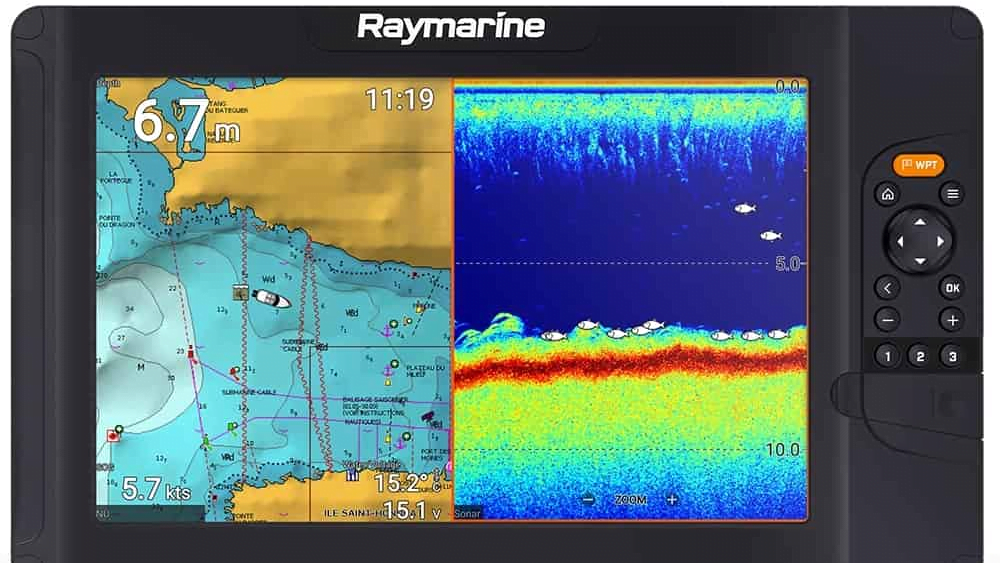
Chirp technologija
Šios technologijos veikimo principas slypi paketiniame impulsų siuntime, kuris leidžia daug geriau ir tiksliau atrinkti povandeninius objektus. Tokių echolotų vaizdo kokybė yra detalesnė ir mažiau triukšminga.
Šoninio skanavimo technologija
Tokiuose echolotuose spinduliai nukreipiami ne tik žemyn po valtimi, bet ir į jos šonus. Echolotai su šoninio skenavimo funkcija turi galimybę nuskaityti povandeninę erdvę, kairėje ir dešinėje nuo valties, dešimtis metrų. Išsamiausias situacijos po vandeniu vaizdas gaunamas sujungus informaciją, gautą iš šoninių spindulių su informacija iš apatinio pluošto.
Klasikinio ir skenuojančio echoloto veikimo skirtumas yra tas, kad klasikinio echoloto spindulio projekcija apačioje yra apskritimas, kurio skersmuo priklauso nuo spindulio kampo ir gylio, o spindulių projekcija skenuojantis echolotas yra siaura juostelė.

